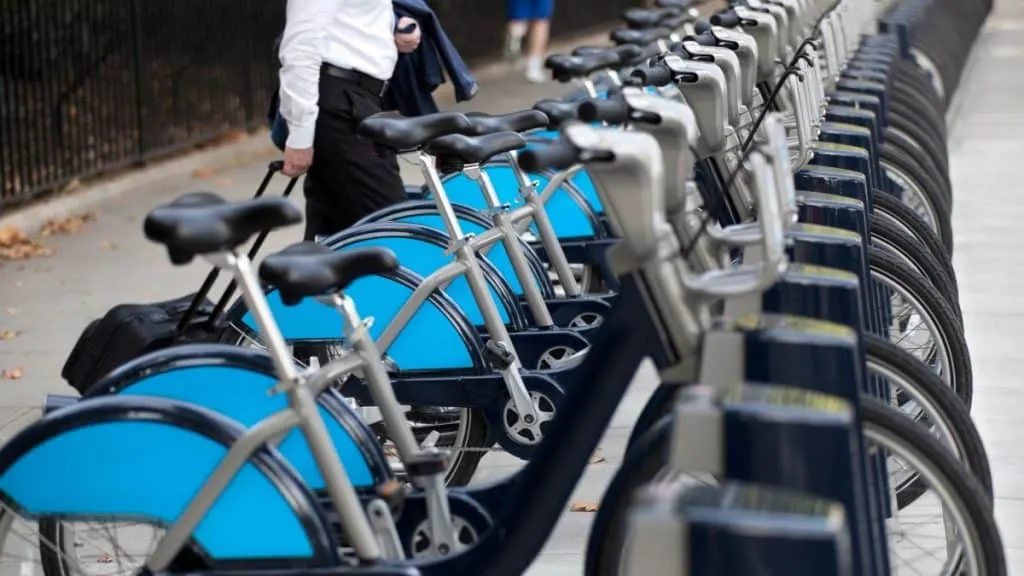
Many people opt to cycle to work not just to stay in shape, but to save a bit of money. With unpredictable gas prices, costly car insurance, and car repair expenses, you may be looking for a less expensive way to commute. So how much money can you actually save by cycling to work?
Overall, you can expect to save anywhere from $350-$1000 a month by cycling to work. The amount of money you save will vary depending on factors such as how far your workplace is from where you live, how much you pay on car expenses, where you are located, etc.
To calculate how much money you can save by cycling to work as well as getting prepared for your daily commute, keep reading…
This article will take you through the specifics of how to figure out exactly how much money you could be saving when weighing up the costs of owning a bike against the savings you could be making by not driving to work.
Let’s take a look at the factors you need to take into consideration…
How Cycling to Work Saves You Money
There are numerous ways cycling to work can save you money, maybe some that you haven’t even considered. As you go through this list, jot down a rough amount of your monthly expenses in these catagories to get an idea of what you could save. Your findings may surprise you!
Cost of Gas
As you consider cycling to work to save money, gas prices are probably one of the first thoughts to cross your mind. You really can’t beat the price of $0 dollars it costs to ride a bike!
The average cost of gas is around $70 for a tank of gas, depending on your location and commute to work. Cycling to work sounds much more appealing now, right?
Cost of Auto Insurance
Additionally, if you plan on cycling as your main form of transportation, you can save a good deal of money on auto insurance. If you have a family car that you can use to run errands and use to go out, it may be worth it to nix the auto insurance on your car.
Most insurance companies give discounts if you drive your car less than 5000 miles annually, so before reverting to your car for your commute or even a short errand, turn to your bike instead.
Cost of Oil Changes and Car Repairs
By cutting down on the time you spend in your car, you are less likely to have as many car repairs and oil changes to pay for. Depending on the shape that your car is in, this may or may not apply to you.
However, there is no doubt that cycling will save miles on your car, keeping it in better condition longer, equating to financial savings as well.
Tolls During your Commute by Car
Depending on where you live, toll costs can really add up. This is one of the many reasons, aside from the warm weather, that places like Florida have multiple cyclists.
If your commute in your car to and from work costs $5-$10, it may not seem like much, but you could save around $150-$300 a month just by cycling to work. That adds up to a savings of $1,800-$3,600 a year!
Cost of Parking your Car
Similar to tolls, even small parking costs can add up to high amounts over the course of a year. If you are required to park in a parking garage, it may be worthwhile to cycle to work and lock up your bike on a bike rack instead.
As an added benefit, you will not need to wait in parking garage traffic or waste time trying to find a parking spot in high traffic areas.
How Much Money You Can Save by Cycling to Work Each Month
It sounds like a great idea to save money by cycling to work, but seeing it in numbers could help with your decision of whether to do so or not.
The table below provides a range of cost savings and is based on the average amount people pay on gas, auto insurance, tolls, and parking.
| Gas | Auto Insurance | Tolls | Parking | |
|---|---|---|---|---|
| Below Average Costs | $20-$40 | $100-$200 | $100-$150 | $100-$150 |
| Average Costs | $40-$60 | $200-$300 | $150-$200 | $150-$200 |
| Above Average Costs | $60-$80 | $300-$400 | $200-$250 | $200-$250 |
You will need to calculate your own expenses to get the best estimate, but you can get a rough idea with the table above.
Based on the average driving expenses, you can save around $500-$760 each month. And when you add up those dollars annually, it makes more and more sense to begin to cycle to commute to work.
Saving on Public Transportation when Cycling to Work

If you rely on public transportation to get to work, cycling can still have the potential to save you some money.
On average, people who use public transportation spend roughly $100 a month. By cycling to work, you can save over $1,000 a year. Keep in mind that this average may fluctuate, depending on where you live.
Indirect Ways Cycling to Work May Save You Money
Cycling to work has the potential to save you more money than just time cost. Over time, cycling to work will truly pay for itself and then some, depending on how often you commute via bicycle. Below are some of the long-term costs you may be able to save on.
- Tax Breaks for Employees Who Cycle – Depending on your employer, you may be eligible for a tax break. If cycling to work is your regular form of transportation, then you could get up to around $20 a month to cover bike costs. Your employer will need to be a part of a commuter benefit program to receive it.
- Gym Membership – If you are cycling a few miles to and from your place of work, you may find a gym membership unnecessary. Cycling can help build leg muscles and is a great form of cardiovascular exercise. It naturally keeps you in shape and is a fun exercise to do.
- Healthcare – If you have health issues, such as cardiovascular disease, cycling may help your overall health resulting in fewer doctor visits. Regular exercise is beneficial to your health in general and is great as preventative care. Consult with your doctor to see if cycling to work is a good choice for you and your health.
- Increased Productivity – Although your productivity levels do not translate directly into dollars, you may feel more motivated once you get to work. Commutes can be stressful and exhausting, whereas cycling can give you an endorphin boost before work. Your employer may take notice, and this could result in a raise 😉
Where you Live can Affect How Much You Save
The amount of money you will be able to save by cycling to work can be quite significant, but will differ according to where you live.
Cutting down on driving is definitely one way to save hundreds or even thousands of dollars, but biking is more cost efficient than driving or even taking public transportation as well.
Of course, living in more urban areas with a high density population is more expensive overall than in the suburbs. Public transportation may be convenient in a big city, but the cost also adds up.
For example, a monthly metro pass in Washington D.C. averages nearly $1000 per year. Chicago and Los Angeles are even higher, coming in close to $1500 per year. Add in other costs like bus fare or taking taxis from time to time and soon your transportation cost is eating into your budget.
Cycling to work helps to cut that cost down, especially because maintenance cost is so low. The added benefit is that in between work days, when you have free time, your bike is available to take a long, leisurely ride on the weekends to stay in shape and unwind.
The Hidden Cost of Time
If you are in a city area, some may argue that taking public transportation is still a significant money saver compared to driving a car, but what about the cost of time? So many people spend a significant part of their day commuting across large cities and have to deal with “people traffic”.
Additionally, not being at the mercy of timetables of commuter trains changing or worrying about a bus breaking down, cycling to work means you run your own schedule and can bypass all the other modes of transportation.
If you think that your commute is too long in your city, studies have shown that map applications on our cell phones actually overestimate the time it takes to bike to work. Experiment on your own and time yourself by biking to work; you may be surprised at how much faster it is!
Cycling to work could potentially take less time than commuting via public transport, and as the saying goes, “time is money”.
Imagine getting more of your time back so you could have more free time or even take on a side project to earn extra money. Gaining back time in your day is a most priceless asset.
The Costs of Using a Bike Versus Driving a Car to Commute

Cycling to work has the potential to save you money in the long run. However, you will need to spend a little upfront. Bike costs range from a few hundred dollars to over a thousand.
Additionally, you may need items like a basket, lock, and emergency supplies including a spare tire, air pump, and first aid kit. Expect to spend roughly $500-$1000 to get started.
TIP: Check out my “Recommended Gear” Section for guidance on choosing the right type of cycling gear for your needs, and getting everything you need to ensure a successful and safe cycling commute.
But compared to owning, maintaining, and putting gas into a car, it is a small investment to make in a commuter bike than spending thousands of dollars a year on a vehicle.
If you still choose to own and drive a car, as you read previously, cutting back on its usage adds up to significant savings. Perhaps finding a great compromise between using your car or your bike is a good way to find balance.
Did you know that most of the errands we run, places we go to often, and other driving destinations are on average in a four-mile radius of our homes?
What if, instead of taking your car each time to an errand, you began to take your bike just like using it to commute to work? This “4 mile rule” could also help you to save money and keep up your cycling routine.
Bike Sharing Opportunities for Cycling to Work
Perhaps you don’t want to invest in a bike or simply lack the extra funds to buy one. The good news is that more and more bike sharing programs are on the rise in urban cities across many countries.
Using such a program seems like the perfect way to test if you are truly ready to invest in a great bike to commute to work. And it also gives you an opportunity to save on some gas while you borrow the bike. You can use these savings to put towards your own bike in the future.
Bike sharing allows you to rent a bike for a short period of time, often conveniently placed in bike hubs where you can rent and return the bikes. Being able to come and go as you please, especially while cycling to work, relieves the burden of hoping your bike will not be stolen or damaged when it is out of your sight.
It also provides more convenience for those who do hybrid commutes where they use both a bike and public transportation for traveling long distances to the office.
Types of Fees Associated with Bike Sharing
Most bike sharing programs have these types of user fees:
- Membership Fee – A membership fee is pretty standard nowadays with bike sharing programs and acts like a deposit for using the company’s bikes.
- Flat or Monthly Fee – A flat or monthly fee is usually available in time increments, like monthly passes or six to twelve months. If you become a frequent user, this tends to be the most economical choice for your wallet.
- Per Use Fee – This type of fee is a bit higher per use than buying a monthly pass, but still costs significantly less than using public transportation or using your car.
Bike sharing programs are convenient and support you leaving less of a carbon footprint, but be careful when using the programs. Some companies will charge up to $1200 to replace a damaged or stolen bike.
Be responsible with the bike you rent and you will never have to worry about paying such a high fee and otherwise defeating your purpose of saving money while cycling to work.
Advantages of Bike Sharing
Engaging in a bike sharing program has a great many benefits associated with it. Besides saving you money and providing a great and fun way to exercise, here are a few more in particular:
- No Need to Own a Bike – Using a bike sharing program means you can save even more money cycling to work because you will not have to invest in your own bike and its maintenance. A monthly pass is also usually less than public transportation fees.
- More Options – Even if you commit to cycling to work, what about bad weather? While some bike commuters are hardcore about their choice to bike to work, you may not feel the same way. Using bike share gives you the option of taking other means of transportation when you so desire, without feeling guilty about not using your own bike.
- Extremely Convenient – Most bike share programs have bike hubs all around big cities, with the hubs being close to places that have public transportation stations. When you finish with the bike you have chosen, simply return it to the nearest parking hub and never worry about your own bike getting stolen or damaged.
Using a bike share program is becoming more and more popular in certain cities and countries around the world. If people use them more often, companies could be in a position to make their fees even more affordable, which translates into savings for bike sharing lovers.

The next time you see a bike share hub, be sure to check one out to get a feel for the convenience of getting around your city on two wheels.
How much money you can save by cycling to work varies depending on:
- your lifestyle
- where you live
- how much you are currently spending on transportation
Spending money upfront on a good bike, a tough lock, and other gear can prevent you from spending more in the long run. Once you are well prepared, cycling to work can be a great way to save money and enjoy your morning commute!
If you’re still unsure, try a bike share program if your city has it or simply rent a bike to test out if this is something feasible for you. And remember, it doesn’t have to be ‘all in’. You can simply start using your bike for some of your journeys. The more you use it, the more money you will save.
However you choose to adapt to a new way of getting to work, it’s clear that cycling has huge advantages and is worth the effort to save a significant amount of money each year.
Check out my article “A Beginners Guide to Choosing the Perfect Bicycle” for a detailed guide on how to choose a good bike for yourself.
